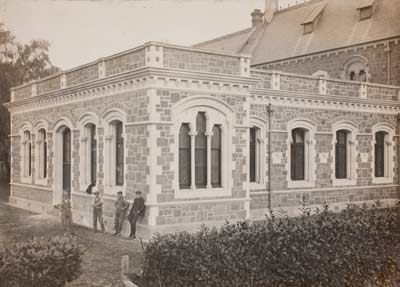By the early 1900s the School of Engineering was rapidly becoming a leading performer for Canterbury College. After just over 20 years in existence the School had produced an impressive 47 graduates and 38 associates. Capitalising on this success, and making the most of his well-heeled connections, Head of Engineering Professor Scott won funding for further expansion to the School, though not without raising some concern amongst his colleagues in other subject areas. The Board of Governors responded to those concerns in 1905 stating “In connection with the School of Engineering … a cheese-paring policy was impossible … [we] must keep on spending.”The Hydraulics Laboratory was designed by Collins and Harman, and built in two stages between 1905 and 1914. The first stage added the ground floor of the laboratory, with a water tank installed on the roof.

Hydraulics Laboratory

The first stage of the Hydraulics Laboratory, completed in 1905. This image was captured during a site inspection by Armson and Collins.
The tank had a 57,000 litre storage capacity and the water was used to create flows of varying depths and intensity for experiments. By 1914 an additional storey had been added to the building at a cost of £3,277. As per Scott’s specifications, this floor was to include a lecture room, departmental library, a workshop, an applied mechanics room, a preparation room, and a lecturers’ study. The addition was designed in such a way that the water tank was enclosed between the 1st and 3rd floors, which explains some of the compromises made in the overall design. One of the anomalies created by the extensions was that the room occupied by the College typist ended up looking out onto a stone wall, and got no direct light from outside.
A strong disagreement arose over building of the Hydraulics Laboratory between Professor Scott and the firm of Collins and Harman. Scott and his staff closely monitored the construction of the laboratory, and raised concerns about the strength of the piers supporting the upper floors. Scott wrote to the Board in a letter marked URGENT stating that “... the Main Floor of the New Engineering Building [was] on the verge of collapse by failure of the columns in the Hydraulic Tank Room…” No doubt to the architect’s chagrin, Scott was instructed by the Board to arrange for strengthening to take place. Perhaps the strengthening wasn’t sufficient, as by the 1930s it was found that the Hydraulics Laboratory had subsided. A staff member at the time wrote he found it rather disquieting to note that “When viewed from the outside, the east wall appears to have bent outwards near the middle of its length.” Appropriately strengthened, by 1978 the Laboratory was home to one of the Arts Centre’s most well-known tenants, the Court Theatre.
Collins and Harman were also responsible for the Electrical Machines Laboratory, which was to be the last major Gothic building constructed on the Canterbury College site. Built in 1923 for a whopping £14,870, the project also included extensions and alterations to the School of Engineering. Featured in the final design are Tudor Gothic elements, and an array of heraldic devices adorn the walls. As with Hydraulics, this building also later became part of the Court Theatre. By now the Engineering School was a sprawling empire, and had considerable impact on the life of the College. A Letter to the Editor of the College Review in 1926 entitled ‘The Dragon in our Midst’ from Blackamoor reads “Dear Sir, Anyone who has crossed the quad when the digestive apparatus of the Engineering School is functioning, will no doubt have had the truly infernal experience of being enveloped with a black pall of disgusting smoke, belched from the stony nostrils of that rumbling dragon’s uplifted snout. I have no notion of the arrangements of this monster’s innards but surely some of the wriggling mass of embryo engineers seething about in the shadow of its vitals might be profitably employed in devising some provisions more congenial to it…?”